 W
WA tooth is a hard, calcified structure found in the jaws of many vertebrates and used to break down food. Some animals, particularly carnivores, also use teeth for hunting or for defensive purposes. The roots of teeth are covered by gums. Teeth are not made of bone, but rather of multiple tissues of varying density and hardness that originate from the embryonic germ layer, the ectoderm.
 W
WIn dentistry, the term anterior teeth usually refers as a group to the incisors and canine teeth as distinguished from the posterior teeth, which are the premolars and molars. The distinction is one of anterior versus posterior. The distinction holds in both the upper jaw (maxilla) and lower jaw (mandible). As a rough guide, it can be said that the anterior teeth are tailored to biting whereas the posterior teeth are tailored to chewing.
 W
WThe ASUDAS is a reference system for collecting data on human tooth morphology and variation created by Christy G. Turner II, Christian R. Nichol, and G. Richard Scott. The ASUDAS gives detailed descriptions for common crown and root shape variants and their different degrees of expression. It also comprises a set of reference plaques illustrating dental variants as well as showing their expression levels in 3D. The ASUDAS was designed to ensure a standardized scoring procedure with minimum error in order to warrant comparability between data collected by different observers.
 W
WIn mammalian oral anatomy, the canine teeth, also called cuspids, dog teeth, or fangs, eye teeth, vampire teeth, or vampire fangs, are the relatively long, pointed teeth. They can appear more flattened however, causing them to resemble incisors and leading them to be called incisiform. They developed and are used primarily for firmly holding food in order to tear it apart, and occasionally as weapons. They are often the largest teeth in a mammal's mouth. Individuals of most species that develop them normally have four, two in the upper jaw and two in the lower, separated within each jaw by incisors; humans and dogs are examples. In most species, canines are the anterior-most teeth in the maxillary bone.
 W
WThe age of cattle is determined chiefly by examination of the teeth, and less perfectly by the horn rings or the length of the tail brush; however due to bang-tailing, which is the act of cutting the long hairs at the tip of the tail short to identify the animal after management practices, the latter is least reliable.
 W
WCementum is a specialized calcified substance covering the root of a tooth. The cementum is the part of the periodontium that attaches the teeth to the alveolar bone by anchoring the periodontal ligament.
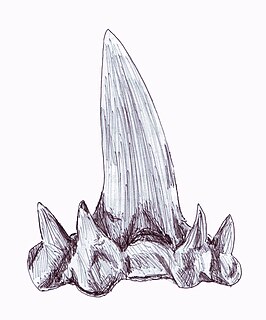 W
WCladodont is the term for a common category of early Devonian shark known primarily for its "multi-cusped" tooth consisting of one long blade surrounded by many short, fork-like tines, designed to catch food that was swallowed whole, instead of being used to saw off chunks of meat like many modern sharks. The skinny teeth would puncture and grasp the prey, keeping it from wriggling free.
 W
WDentition pertains to the development of teeth and their arrangement in the mouth. In particular, it is the characteristic arrangement, kind, and number of teeth in a given species at a given age. That is, the number, type, and morpho-physiology of the teeth of an animal.
 W
WA diastema is a space or gap between two teeth. Many species of mammals have diastemata as a normal feature, most commonly between the incisors and molars. Diastemata are common for children and can exist in adult teeth as well. Diastemata are primarily caused by imbalance in the relationship between the jaw and the size of the teeth.
 W
WDinosaur teeth have been studied since 1822 when Mary Ann Mantell (1795-1869) and her husband Dr Gideon Algernon Mantell (1790-1852) discovered an Iguanodon tooth in Sussex in England. Unlike mammal teeth, individual dinosaur teeth are generally not considered by paleontologists to be diagnostic to the genus or species level for unknown taxa, due morphological convergence and variability between teeth. and many historically named tooth taxa like Paronychodon and Richardoestesia are today considered nomina dubia, and are used as form taxa to refer to isolated teeth from other localities displaced considerably in time and space from the type specimens. However, it is possible to refer isolated teeth to known taxa provided that the tooth morphology is known and the teeth originate from a similar time and place.
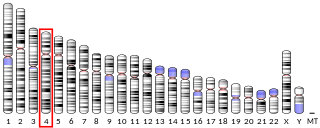 W
WEnamelin is an enamel matrix protein (EMPs), that in humans is encoded by the ENAM gene. It is part of the non-amelogenins, which comprise 10% of the total enamel matrix proteins. It is one of the key proteins thought to be involved in amelogenesis. The formation of enamel's intricate architecture is thought to be rigorously controlled in ameloblasts through interactions of various organic matrix protein molecules that include: enamelin, amelogenin, ameloblastin, tuftelin, dentine sialophosphoprotein, and a variety of enzymes. Enamelin is the largest protein (~168kDa) in the enamel matrix of developing teeth and is the least abundant of total enamel matrix proteins. It is present predominantly at the growing enamel surface.
 W
WA fang is a long, pointed tooth. In mammals, a fang is a modified maxillary tooth, used for biting and tearing flesh. In snakes, it is a specialized tooth that is associated with a venom gland. Spiders also have external fangs, which are part of the chelicerae.
 W
WHorse teeth refers to the dentition of equine species, including horses and donkeys. Equines are both heterodontous and diphyodontous, which means that they have teeth in more than one shape, and have two successive sets of teeth, the deciduous and permanent sets.
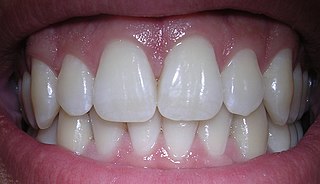 W
WThe human teeth function to mechanically break down items of food by cutting and crushing them in preparation for swallowing and digesting. Humans have four types of teeth: incisors, canines, premolars, and molars, which each have a specific function. The incisors cut the food, the canines tear the food and the molars and premolars crush the food. The roots of teeth are embedded in the maxilla or the mandible and are covered by gums. Teeth are made of multiple tissues of varying density and hardness.
 W
WHuman tooth sharpening is the practice of manually sharpening the teeth, usually the front incisors. Filed teeth are customary in various cultures. Many remojadas figurines found in part of Mexico have filed teeth and it is believed to have been common practice in their culture. The Zappo Zap people of the Democratic Republic of Congo are believed to have filed their teeth.
 W
WHutchinson's teeth is a sign of congenital syphilis. Affected people have teeth that are smaller and more widely spaced than normal and which have notches on their biting surfaces. It is named after Sir Jonathan Hutchinson, an English surgeon and pathologist, who first described it.
 W
WHyperdontia is the condition of having supernumerary teeth, or teeth that appear in addition to the regular number of teeth. They can appear in any area of the dental arch and can affect any dental organ. The opposite of hyperdontia is hypodontia, where there is a congenital lack of teeth, which is a condition seen more commonly than hyperdontia. The scientific definition of hyperdontia is "any tooth or odontogenic structure that is formed from tooth germ in excess of usual number for any given region of the dental arch." The additional teeth, which may be few or many, can occur on any place in the dental arch. Their arrangement may be symmetrical or non-symmetrical.
 W
WThe Lewis offset is a term for the portion of the central groove on a permanent mandibular first molar which lies between the two central pits. It was named for long time dental anatomy instructor Dr. Christopher S. Lewis, a Mercer Island, WA dentist.
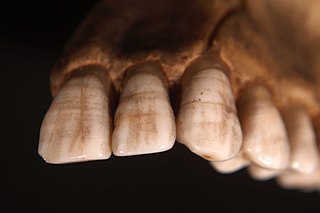 W
WLinear enamel hypoplasia is a failure of the tooth enamel to develop correctly during growth, leaving bands of reduced enamel on a tooth surface. It is the most common type of enamel hypoplasia reported in clinical and archaeological samples, with other types including plane-form enamel hypoplasia and pitting enamel hypoplasia.
 W
WThe Little Mouse, or La Petite Souris, is a fairy tale legend popular in most Francophone countries, most notably in France, and Wallonia. The legend of the Little Mouse ties in with that of the Tooth Fairy, the difference being that in this case, a little mouse sneaks in while the child is asleep, and replaces the lost baby tooth kept under his/her pillow with coins.
 W
WA malocclusion is a misalignment or incorrect relation between the teeth of the two dental arches when they approach each other as the jaws close. The term was coined by Edward Angle, the "father of modern orthodontics", as a derivative of occlusion. This refers to the manner in which opposing teeth meet.
 W
WTeeth are common to most vertebrates, but mammalian teeth are distinctive in having a variety of shapes and functions. This feature first arose among the Therapsida during the Permian, and has continued to the present day. All Therapsid groups with the exception of the mammals are now extinct, but each of these groups possessed different tooth patterns, which aids with the classification of fossils.
 W
WMatthew 5:38 is the thirty-eighth verse of the fifth chapter of the Gospel of Matthew in the New Testament and is part of the Sermon on the Mount. This verse begins the antithesis on the commandment: "Eye for an eye".
 W
WMaxillary lateral incisor agenesis (MLIA) is lack of development (agenesis) of one or both of the maxillary lateral incisor teeth. In normal human dentition, this would be the second tooth on either side from the center of the top row of teeth. The condition is bilateral if the incisor is absent on both sides or unilateral if only one is missing. It appears to have a genetic component.
 W
WMolar incisor hypomineralisation (MIH) or chalky teeth is a type of enamel defect affecting, as the name suggests, the first molars and incisors in the permanent dentition. MIH is considered a worldwide problem and usually occurs in children under 10 years old. This developmental condition is caused by the lack of mineralisation of enamel during its maturation phase, due to interruption to the function of ameloblasts. Many factors have been suggested, such as genetics and medical problems during pregnancy, but only childhood illness, fever in particular, seems to be associated with MIH. However, further studies on the aetiology of MIH are required because it is believed to be multifactorial.
 W
WOdontometrics is the measurement and study of tooth size. It is used in biological anthropology and bioarchaeology to study human phenotypic variation. The rationale for use is similar to that of the study of dentition, the structure and arrangement of teeth. There are a number of features that can be observed in human teeth through the use of odontometrics.
 W
WPharyngeal teeth are teeth in the pharyngeal arch of the throat of cyprinids, suckers, and a number of other fish species otherwise lacking teeth.
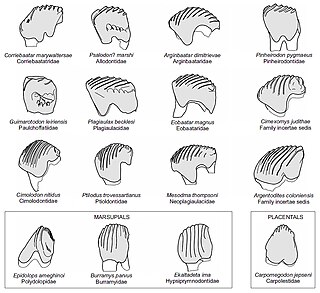 W
WA plagiaulacoid is a type of blade-like, most often serrated, tooth present in various mammal groups, usually a premolar. Among modern species it is present chiefly on diprotodontian marsupials, which have both the upper and lower first premolars converted into serrated blades. However, various other extinct groups also possessed plagiaulacoids. These would be multituberculates, some "Plesiadapiformes" such as Carpolestes and various metatherians such as Epidolops and various early diprotodontians. In many of these only a lower premolar became converted into a blade, while the upper premolars showed less speciation.
 W
WPost-canine megadontia is a relative enlargement of the molars and premolars compared to the size of the incisors and canines. This phenomenon is seen in some early hominid ancestors such as Paranthropus aethiopicus.
 W
WEl Ratoncito Pérez or Ratón Pérez is a figure popular in Spanish and Hispanic American cultures, similar to the tooth fairy, originating in Madrid in 1894. As is traditional in some English-speaking countries, when a child loses a tooth it is customary for him or her to place it under the pillow, so that Ratoncito Pérez will exchange it for a gift. The tradition is almost universal in Spanish cultures, but takes different forms in different areas. He is known as "Ratoncito Pérez" in Spanish speaking countries, with the exception of some regions of Mexico, Guatemala, Peru and Chile, where he is called "el Ratón de los Dientes", and in Argentina, Venezuela, Uruguay and Colombia, he is known simply as "El Ratón Pérez".
 W
WA shark tooth is one of the numerous teeth of a shark. Sharks continually shed their teeth; some Carcharhiniformes shed approximately 35,000 teeth in a lifetime, replacing those that fall out. There are four basic types of shark teeth: dense flattened, needle-like, pointed lower with triangular upper, and non-functional. The type of tooth that a shark has depends on its diet and feeding habits.
 W
WThe striae of Retzius are incremental growth lines or bands seen in tooth enamel. They represent the incremental pattern of enamel, the successive apposition of different layers of enamel during crown formation.
 W
WTeeth blackening or teeth lacquering is a custom of dyeing one's teeth black. It was most predominantly practiced in Southeast Asian and Oceanic cultures, particularly among Austronesian, Austroasiatic, and Kra-Dai-speaking peoples. It was also practiced in Japan prior to the Meiji era, as well as in India. It was also performed among some groups in the Americas, most notably among the Shuar people of northern Peru and Ecuador. Also in Russia at least since XVII.
 W
WA teether, teething toy, or chew toy is a device given to teething infants. Most modern teethers are silicone, but can also be made of wood or rubber. Some teethers are filled with a fluid or gel that can be frozen or refrigerated. They differ from pacifiers in that they are intended to be chewed, rather than sucked on. They come in a variety of different shapes. Teethers may help relieve teething pain and help new teeth penetrate the gum, as well as provide a form of entertainment. Teething necklaces and teething bracelets may pose a choking hazard to infants and toddlers depending on the teething parts, and have prompted recalls. Early teethers were often teething rings.
 W
WTeething is the process by which an infant's first teeth sequentially appear by emerging through the gums, typically arriving in pairs. The mandibular central incisors are the first primary teeth to erupt, usually between 6 and 10 months of age. It can take several years for all 20 teeth to complete the tooth eruption. Though the process of teething is sometimes referred to as "cutting teeth", when teeth emerge through the gums they do not cut through the flesh. Instead, hormones are released within the body that cause some cells in the gums to die and separate, allowing the teeth to come through.
 W
WTooth eruption is a process in tooth development in which the teeth enter the mouth and become visible. It is currently believed that the periodontal ligament plays an important role in tooth eruption. The first human teeth to appear, the deciduous (primary) teeth, erupt into the mouth from around 6 months until 2 years of age, in a process known as "teething". These teeth are the only ones in the mouth until a person is about 6 years old creating the primary dentition stage. At that time, the first permanent tooth erupts and begins a time in which there is a combination of primary and permanent teeth, known as the mixed dentition stage, which lasts until the last primary tooth is lost. Then, the remaining permanent teeth erupt into the mouth during the permanent dentition stage.
 W
WThe Tooth Fairy is a fantasy figure of early childhood in Western and Western-influenced cultures. The folklore states that when children lose one of their baby teeth, they should place it underneath their pillow or on their bedside table and the Tooth Fairy will visit while they sleep, replacing the lost tooth with a small payment.
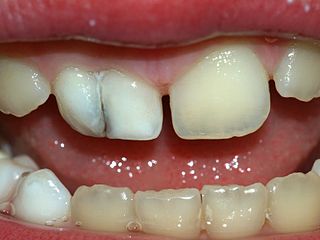 W
WTooth fusion arises through union of two normally separated tooth germs, and depending upon the stage of development of the teeth at the time of union, it may be either complete or incomplete. On some occasions, two independent pulp chambers and root canals can be seen. However, fusion can also be the union of a normal tooth bud to a supernumerary tooth germ. In these cases, the number of teeth is fewer if the anomalous tooth is counted as one tooth. In geminated teeth, division is usually incomplete and results in a large tooth crown that has a single root and a single canal. Both gemination and fusion are prevalent in primary dentition, with incisors being more affected.
 W
WA toothcomb is a dental structure found in some mammals, comprising a group of front teeth arranged in a manner that facilitates grooming, similar to a hair comb. The toothcomb occurs in lemuriform primates, treeshrews, colugos, hyraxes, and some African antelopes. The structures evolved independently in different types of mammals through convergent evolution and vary both in dental composition and structure. In most mammals the comb is formed by a group of teeth with fine spaces between them. The toothcombs in most mammals include incisors only, while in lemuriform primates they include incisors and canine teeth that tilt forward at the front of the lower jaw, followed by a canine-shaped first premolar. The toothcombs of colugos and hyraxes take a different form with the individual incisors being serrated, providing multiple tines per tooth.
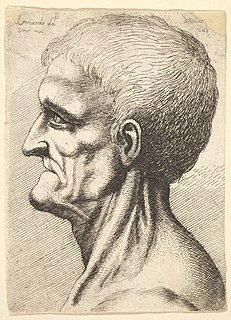 W
WToothlessness or edentulism is the condition of having no teeth. In organisms that naturally have teeth, it is the result of tooth loss.
 W
WToothpaste is a paste or gel dentifrice used with a toothbrush to clean and maintain the aesthetics and health of teeth. Toothpaste is used to promote oral hygiene: it is an abrasive that aids in removing dental plaque and food from the teeth, assists in suppressing halitosis, and delivers active ingredients to help prevent tooth decay and gum disease (gingivitis). Salt and sodium bicarbonate are among materials that can be substituted for commercial toothpaste. Large amounts of swallowed toothpaste can be toxic.
 W
WTuftelin is an acidic phosphorylated glycoprotein found in tooth enamel. In humans, the Tuftelin protein is encoded by the TUFT1 gene. It is an acidic protein that is thought to play a role in dental enamel mineralization and is implicated in caries susceptibility. It is also thought to be involved with adaptation to hypoxia, mesenchymal stem cell function, and neurotrophin nerve growth factor mediated neuronal differentiation.
 W
WIn Japan, yaeba are human teeth, especially upper canines, with an uncommonly fang-like appearance. In Japan it is perceived as a sign of youthfulness and natural beauty. In 2013 it had become a trend where teenage girls would undergo dental procedures to cap the upper canines.